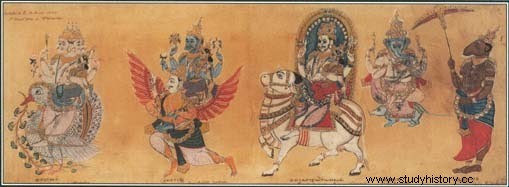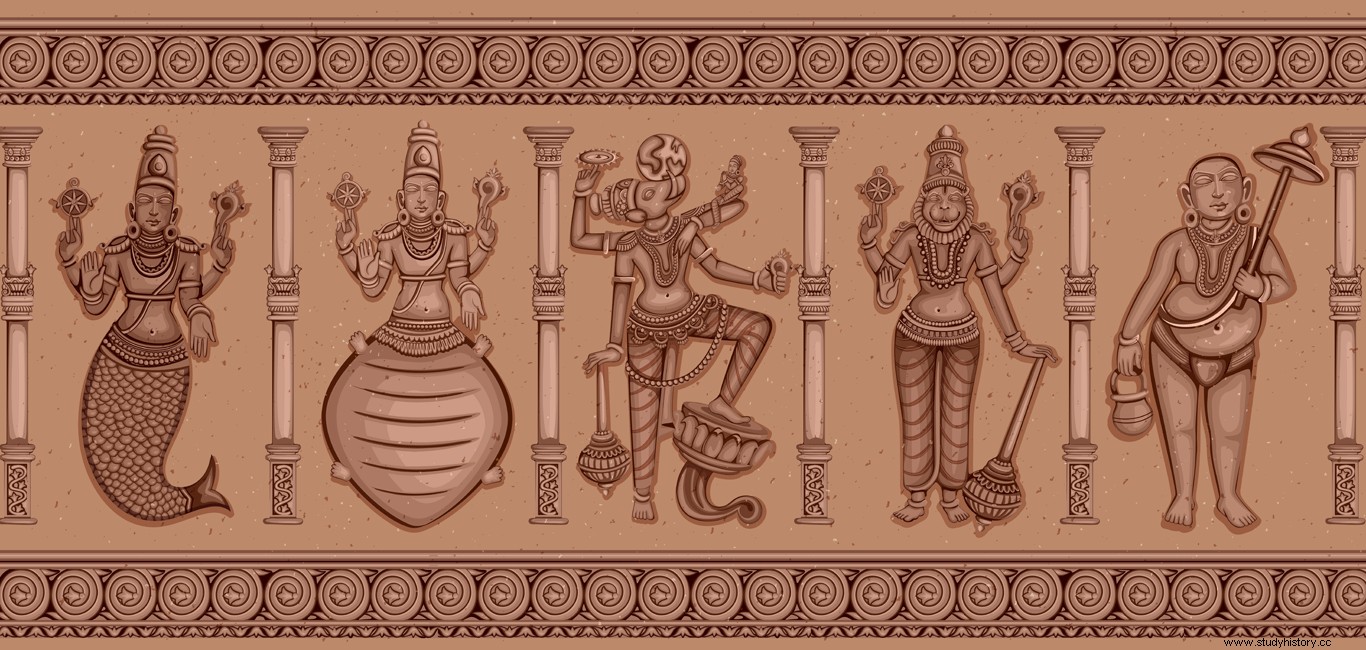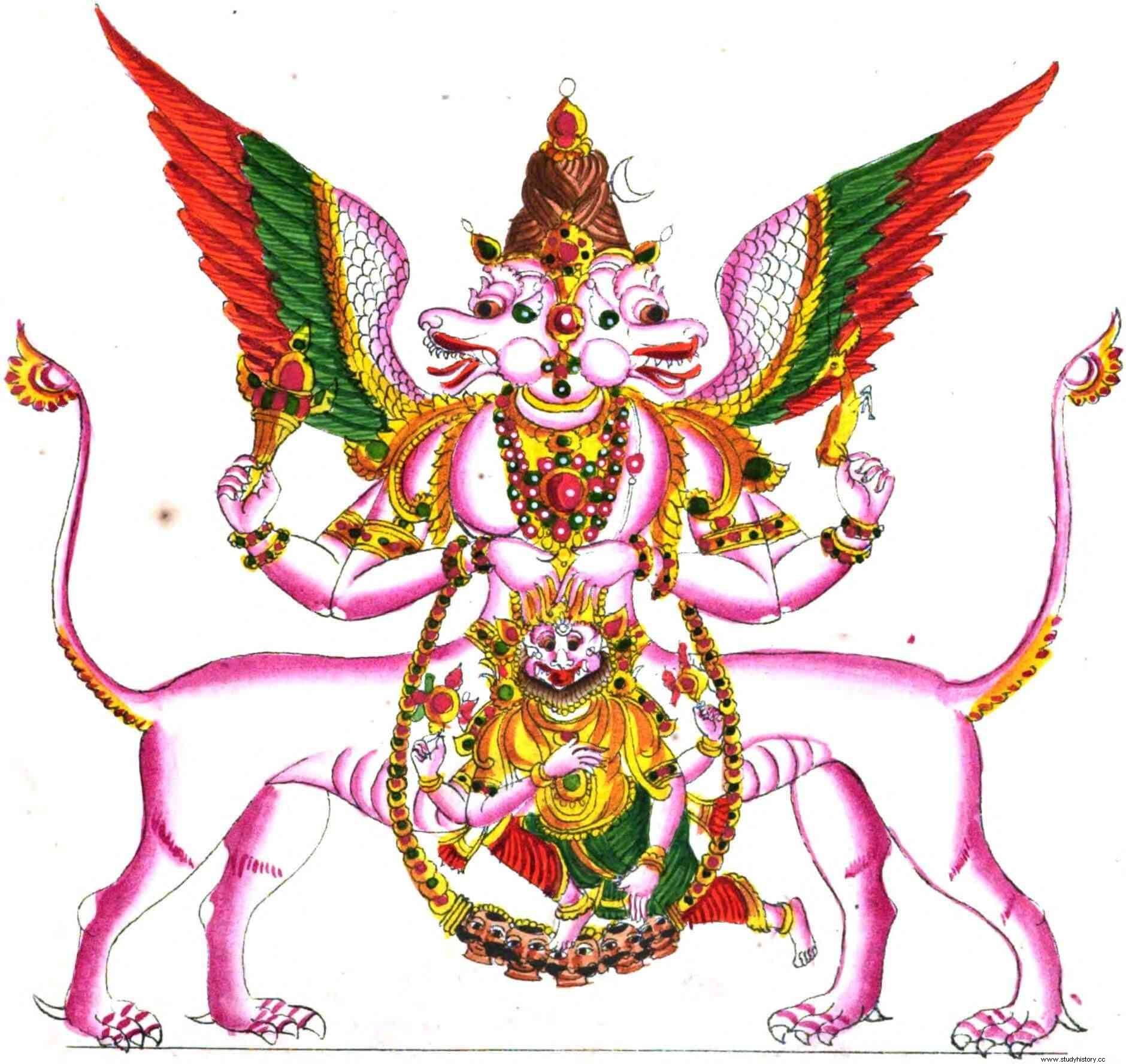Hinduism is one of the oldest religions in the world, with millions of followers all over the world. For well over 3,000 years, Hinduism, through its mythology, has accumulated sacred stories and heroic epics which constitutes the mythology of Hinduism. While nothing in this complex and colorful Hindu mythology changes, the basis of belief remains the same. It pulsates with creation, destruction, love and war, which change and change. Most Hindu myths occur in several different versions. In addition, religion has many characters with multiple roles, identities and stories. This apparent confusion reflects the richness of a mythology that has expanded and taken on new meanings over the centuries.
The Hindu religion is the oldest religion whose origins go back to prehistoric times. Specifically around 5000 to 10,000 BC. So it is no wonder that many of the myths, beliefs and mythologies surrounding religion are just as old. In fact, given this timeline, many of these mythologies may have gone through a number of retellings over the years. Hindu mythology has a rich history, enigmatic characters, resounding stories. As well as a surprising innate connection to modern science. There are also cyclical periods that repeat after a certain interval. You must have heard of epics like Mahabharata and Ramayana, as the former is the longest known epic in history.
The origin of Hindu mythology

Around 1700 BC. People from northwestern India began to migrate to India. More specifically, they are called Aryans or Indo-Europeans. They brought a mythical tradition that became the basis for an early form of Hindu mythology. Over the years, as the Aryans mingled with the peoples and cultures of the Indian subcontinent, the mythology became increasingly complex.
Hindu mythology has gone through various stages, which have a link to the most important texts that survive from each period. The earliest stage has an association with the Vedas, the oldest Indian document. One of the associations of Hindu mythology, the Rig-Veda, is a collection of 1,028 hymns and prayers to the gods with references to myths. The Vedas are based on ancient Aryan traditions. These traditions in Hindu mythology have an oral form of communication.
Consequently, there are certain key beliefs in Hindu mythology that form the background against which the myths unfold. One of these is the idea of reincarnation, sometimes called transmigration of souls. In the belief in Hindu mythology, every soul experiences many, many lives. After the death of a body or incarnation, the soul is born again into a new living body. Even the gods can have a human form of reincarnation.
Just as the individual soul is continually reborn, the universe constantly creates and destroys life. Time moves in cycles of millions of years, endlessly built up and torn down without beginning or end. All change and decay is part of a divinely directed cosmic dance that will ultimately result in renewal. Faced with this enormous pattern, each individual has a duty to follow his own pattern of proper behavior, called Dharma in Hindu mythology.Hindu mythological stories
 Dedication to Ekalavya
Dedication to Ekalavya Ekalavya was a young boy who lived with his tribe, deep in the forest. His goal in life was to become the best archer the world had ever seen. But when he applied to become Drona's student, he was rejected due to the low status of his birth. Despite this, Ekalavya created a statue of Drona and practiced archery before it, until he became incredibly skilled. But when Drona met him and found out about his achievements, he was afraid that a tribal boy would surpass his best student, Arjuna. He demanded that Ekalavya sacrifice his own thumb as payment for learning under his name. Without asking Drona, Ekalavya immediately cut off his right thumb and gave it to him, and was therefore unable to become the best archer in the world.
The Devotion of Surdas
Surdas was one of the greatest devotees of Lord Krishna. He loved Krishna so much that he wrote over a lakh of devotional songs in his honor. Surdas was a blind man, according to the story, who once removed Radha's ankle when she followed him. When asked to return it, he refused, stating that he could not confirm her identity when he was blind. At this point, Krishna blessed him with sight, after which Surdas begged Krishna to remove his sight again. When asked why, he said he had seen Krishna and there was nothing else he wanted to see again.
The Courage of Abhimanyu
Abhimanyu was one of the greatest warriors of the Kurukshetra War. While his mother, Subhadra, was pregnant with him, his father, Arjuna, told her the battle formation technique Chakravyuha. Abhimanyu learned the whole technique from the womb, but fell asleep just before Arjuna revealed how to escape the formation. During the war, Abhimanyu was captured inside the Chakravyuha created by the Kaurava army. Although he did not learn to escape, he gave up his life and fought for his parents and family.
Ramas integrity
Everyone knows Ramayana, the epic that tells the stories of the sixth incarnation of Mahavishnu, Lord Rama. In Ramayana, Rama is forced to leave his kingdom and go into exile with his brother, Lakshmana, and his wife, Sita. Near the end of his exile, Ravana, the king of Lanka, kidnaps his wife and holds her hostage. In the face of all the terrible odds, Rama manages to fight Ravana and his huge army, defeating them and saving his wife.
The strength of Durga
When the Asura king Mahishasura defeats Indra, the king of the gods, and takes his place in heaven, the great goddess Durga is created by the divine energies of all the gods combined. She then takes on Mahishasura, Buffalo Demon, defeats him and his entire army, saving the world.
Prahladas tro
Prahlada, the son of the demon Hiranyakashipu, was a great supporter of Vishnu. However, his arrogant father hated Vishnu when he considered himself the only true God, because of the blessing he had received from Lord Brahma. He tries to kill Prahlada with many methods, but each time Vishnu is Prahlada's rescue. After Hiranyakashipu's last attempt at Prahlada's life, he is killed by Narasimha, the male-lion incarnation of Vishnu.
The focus of Arjuna
When the Pandavas were young, they trained under Drona, the battle champion. The drone wanted to test his pupils, so he stuck a toy bird in a tree and asked them all to straighten their bows towards the eye. When he asked them what they could see, the Pandavas gave different answers, such as the bird, the leaves, the tree, and so on, and missed. Only Arjuna, without missing a beat, said he could see nothing more than the eye of the bird. Satisfied, Drona asked Arjuna to shoot. Arjuna's arrow pierced the bird's eye perfectly.
The strength of Sita
Later, Rama and Sita return to Ayodhya, as king and queen, and begin a prosperous rule. However, rumors began to spread about Sita, who had been living with another man, Ravana (even though it was against her will). To verify these rumors and ensure the continued faith of his subjects, Rama banished Sita to the forest, where she lived with Valmiki. Here she gave birth to twin boys and raised them as a single mother, all alone.
Shravanas loyalty
Shravana was a poor teenage boy who helped his parents on a pilgrimage to all the religious sites in India. When they were old and blind, he carried them in two baskets slung over his shoulders. As he crosses the forests of Ayodhya, Prince Dasharatha's stubborn arrow hits Shravana and he dies. Even with his dying breath, he asks Dasharatha to carry water for his thirsty parents.
Mandodari's Patience
Mandodari was the wife of Ravana. While committing atrocities and atrocities, she spent days trying her best to convince him to be just and honorable. She even asked him to free Sita, even though her advice fell on deaf ears. In the end, she remained loyal to her husband.
Hindu Mythological Creatures

Airavat
The legendary white elephant that served as Indra's mountain
The Hindu mythological creature Airavat was born when Brahma sang seven sacred hymns over the two halves of the eggshell from which Garuda hatched. He is also the reason behind the myth that elephants can bring clouds. According to a legend, when Indra defeated Vritasur, the drought demon. Consequently, Airavat reached down to the water-rich underworld with its trunk and sprayed the water into the clouds. Indra then caused the watery clouds to rain down over the drought-stricken land.
Nandi
Shiva's ox, the protector of all animals, who calmed the angry Shiva
The Hindu mythological creature Kamadhenu, the mother of all cows, begins to give birth to many calves, the milk from all flooded Shiva's home. This disturbed his meditation and made him really angry. And he struck the cows with a bolt of fire from his third eye. To calm him down, the gods offered him a magnificent ox, Nandi, the son of Kasyapa and Kamadehnu.
Narasimha
A fierce combination of a lion and a man
The Hindu mythological creature Hiranyakasyipu, the king of Asura, had a blessing from Brahma that made him almost indestructible. He could not die either on earth or in space; or in fire or in water; neither by day nor by night; neither inside nor outside (of a home); nor by man, beast, or God; neither of a lifeless nor of a lifeless being.
To kill Hiranyakasyipu, Vishnu took the form of Narasimha (a man-lion form). He came out to kill at dusk (neither day nor night); on the doorstep of his palace (neither inside nor outside); used the nails to kill (neither lively nor lifeless); lay him on his lap before he kills (neither the earth nor in space). The blessing was thus rendered ineffective.
Sharabha
The cannibalistic bird created to tame Narasimha
After he killed Hiranyakashipu, the Hindu mythological creature Narasimha was still angry! Many efforts were made to calm him down. Prahalada, one of Vishnu's greatest devotees, was sent by Brahma, and all his efforts were in vain. All the gods were afraid and went to Shiva for help in calming Vishnu. Shiva then appeared in its most destructive form, Sharabha. It is said to be a giant, scary, cannibal bird form. Sharabha scratched Narashima's wings and carried him into the distance.
Sheshnaag
The 1000-head hose that keeps the ground stable
The Hindu mythological creature Sheshnaag had 1,000 brothers who always created problems for everyone around them. Tired of living in such bad company, Sheshnaag left his home and went to the Himalayas. He began to meditate and observe severe penance for the works of the brothers. Impressed by this, Brahma offered him a blessing, but Sheshnaag only asked to become a spiritual servant. So Brahma asked Sheshnaag to wrap himself around the earth and keep it steady, which he gladly accepted. It is said that when Sheshnaag winds its way forward, creation takes place, and when it winds its way backwards, the universe ceases to exist.
Kamadhenu
Mother of all cows
The Hindu mythological creature Kamadhenu, also known as Surabhi, is the original mother of all cows. It is believed that the cow was created under the core of the cosmic sea, and is in presentation to the seven sages of the gods. Every part of the cow's body has religious symbolism. Its four legs symbolize the four Vedas, and its breasts the four Purusharthas. The horns symbolize the gods, the face symbolizes the sun and the moon, the shoulders symbolize fire. Consequently, there is also a belief that it fulfills all the wishes of its owner, and therefore it is also known as the "cow of abundance".
Garuda
The most famous winged beast in Indian mythology
The Hindu mythological creature Garuda and his mother were slaves of the serpents. To be free, Garuda had to go to Indra's kingdom and steal the Amrites. So Garuda did just that, even though he had to fight against all of Indra's power to do so. He and his mother were released immediately.
However, Vishnu asked him to stop the snakes from drinking the amrit. Just as the snakes were about to drink the amrit, Garuda asked them to clean up first. When the snakes were gone and cleaned up, Indra attacked Garuda and tried to claim the amrit. Garuda managed to crush Indra's lightning, but failed to keep the amrit. However, a few drops of amrit fell to the ground and the snakes licked it. The Amrites were so strong that it burned their tongues. Apparently that's why snakes have clapped their tongues.
the conclusion
Indian mythology is definitely a treasure trove of stories. The oldest religion in the world has its jewels in the form of stories and mythological creatures that predict miracles. Which Hindu mythological tale teases you? And which Hindu mythological creature enchants your mind? Let me know in the comments section below.
